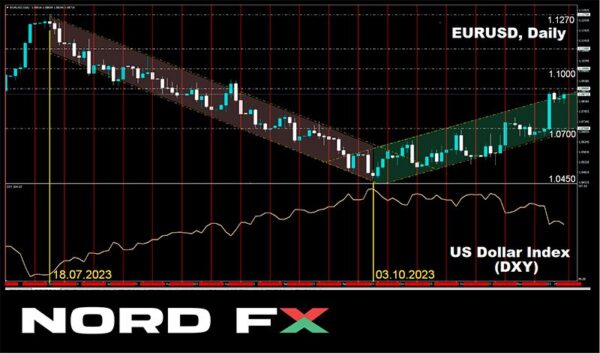EUR/USD: November 14 – a Dark Day for the Dollar
In the previous review, the overwhelming majority of experts expressed opinions favouring further weakening of the American currency. This prediction came to fruition. The Consumer Inflation report in the United States, published on Tuesday, November 14, toppled the Dollar Index (DXY) from 105.75 to 103.84. According to Bank of America, this marked the most significant dollar sell-off since the beginning of the year. Naturally, this had an impact, including on the dynamics of EUR/USD, which marked this day with an impressive bullish candle, rising nearly 200 points.
It is noteworthy that exactly a year ago, after the release of data on October inflation, U.S. bond yields plummeted, stock indices soared, and the dollar significantly declined against major world currencies. And history repeated itself. This time, the Consumer Price Index (CPI) in the U.S. for October decreased from 0.4% to 0% (m/m), and on an annual basis, it dropped from 3.7% to 3.2%. The Core CPI for the same period decreased from 4.1% to 4.0%: the lowest level since September 2021.
In reality, a 0.1% drop in inflation is not that significant. However, the market’s strong reaction demonstrated how overbought the dollar was. As analysts at ING (Internationale Nederlanden Groep) write, a powerful bullish trend in Q3 this year led to a 4.9% increase in the dollar. Keeping the dollar strong was easy due to the high interest rates and increased yields of U.S. Treasury bonds.
But everything comes to an end at some point. The data released on November 14 confirmed the weakening of inflationary pressure and convinced the market that the Federal Reserve (FRS) would no longer raise the key interest rate. Moreover, market participants now do not rule out that the regulator may shift to easing its monetary policy not in the middle of next summer but as early as the spring of the following year. ING economists believe that the onset of a recession in the U.S. will compel the FRS to cut the rate by 150 basis points in Q2 2024. According to MUFG Bank, the probability of a rate cut in May 2024 is now 80%, in March – 30%. Such a reduction will halt the dollar’s bullish rally, support so-called commodity currencies, and, as MUFG believes, EUR/USD could reach the height of 1.1500 over the next year.
As for the near-term outlook, according to Societe Generale economists, regardless of the outcomes of the Federal Reserve meeting on December 13 and the ECB on December 14, seasonal trends for the euro in the last month of 2023 are bullish. However, the dollar may be supported by weak growth rates in the Eurozone. Germany’s economy is in a state of stagnation, preliminary GDP data for the Eurozone showed a decline of -0.1% in Q3, and the European Commission lowered the economic growth forecast for 2023 from 0.8% to 0.6%. Therefore, the euro may also come under pressure from speculation about a cut in the ECB interest rate.
EUR/USD finished the past week at the level of 1.0913. Currently, experts’ opinions on its immediate future are divided as follows: 60% voted for the strengthening of the dollar, 25% sided with the euro, and 15% remained neutral. As for technical analysis, 100% of trend indicators and oscillators on D1 are coloured green, but 25% of the latter are in overbought territory. The nearest support for the pair is located around 1.0830, then 1.0740, 1.0620-1.0640, 1.0480-1.0520, 1.0450, 1.0375, 1.0200-1.0255, 1.0130, 1.0000. Bulls will encounter resistance in the area, then 1.0945-1.0975 and 1.1065-1.1090, 1.1150, 1.1260-1.1275.
Next week, on Wednesday, November 22, the minutes of the last meeting of the Federal Open Market Committee (FOMC) will be published. On Thursday, November 23, preliminary data on business activity (PMI) in Germany and the Eurozone will be released, and the following day will bring similar indicators from the U.S. Additionally, traders should take into account that on Friday in the United States, markets will close early as the country observes Thanksgiving Day.
GBP/USD: Surprise from UK CPI
The strengthening of the pound on U.S. inflation data turned out to be even greater than that of the euro. On November 14, GBP/USD rose by 240 points, from 1.2265 to 1.2505. This is good news for the British currency. However, there is also bad news: inflation in the United Kingdom is on the decline.
The Consumer Price Index (CPI) in October decreased from 0.5% to 0% (m/m) and fell from 6.7% to 4.6% on an annual basis. The Core CPI for the same period decreased from 6.1% to 5.7%. All these figures turned out to be below expectations and were a surprise not only for the market but also for British officials.
Megan Greene, a member of the Bank of England’s Monetary Policy Committee, stated in an interview with Bloomberg TV on November 16 that despite the current decline in inflation, wage growth in the UK remains incredibly high, and labour productivity is low. These two factors complicate the movement toward the target CPI level of 2.0% and make one wonder whether the Bank of England’s policy is restrictive enough. According to Megan Greene, BoE might have to stick to a restrictive policy longer than anticipated.
If inflation does not bring new surprises, it is unlikely that the Bank of England will continue to raise interest rates in the coming months. But even if it continues to keep it at the current level of 5.25%, while the Federal Reserve starts lowering rates, it will benefit the pound. However, at the moment, making any forecasts is quite challenging.
“We remain cautious for now,” write economists at German Commerzbank. “One surprise does not mean everything is settled. And given the remarkable instability of inflation in the UK, there is a risk that the return to the target inflation level will be uneven. Wage data released on Tuesday also confirms this view. At the moment, the Bank of England can breathe a sigh of relief, but caution is still necessary.”
GBP/USD ended the past week at the level of 1.2462. As for the median forecast of analysts for the near future, here their voices were divided equally: a third of them pointed north, a third to the south, and a third to the east. For D1 trend indicators, 90% point north, 10% to the south. All 100% of oscillators are looking up, with 15% of them signalling overbought conditions. In the event of the pair moving south, it will encounter support levels and zones at 1.2390-1.2420, 1.2330, 1.2210, 1.2040-1.2085, 1.1960, and 1.1800-1.1840, 1.1720, 1.1595-1.1625, 1.1450-1.1475. In the case of the pair rising, it will face resistance at levels 1.2500-1.2510, then 1.2545-1.2575, 1.2690-1.2710, 1.2785-1.2820, 1.2940, and 1.3140.
Events of the upcoming week in the calendar include a speech by Bank of England Governor Andrew Bailey on Tuesday, November 21. The following day will see the release of the Inflation Report and discussion of the country’s budget, and on Thursday, November 23, preliminary data on business activity (PMI) in various sectors of the UK economy will be released.
USD/JPY: U.S. Treasuries Expected to Rescue the Yen
On November 13, USD/JPY reached a height of 151.90, updating a multi-month high and returning to where it traded in October 2022. However, on U.S. inflation data, the yen staged a comeback.
Unlike the U.S. CPI, macro statistics from Japan had minimal impact on the yen, though there were notable points to consider. For instance, the country’s GDP in the third quarter showed a decline of -0.5% after a 1.2% growth in the previous period and a forecast of -0.1%. Against this backdrop, the head of the Bank of Japan (BoJ), Kadsuo Ueda, made a surprising statement on Friday, November 17, stating that the country’s economy is recovering and is likely to continue doing so, albeit at a moderate pace.
Ueda is not certain that the weak yen negatively affects the Japanese economy. On the contrary, this weakness has a positive impact on exports and the profits of Japanese companies operating in the global market. Therefore, the head of the regulator is unsure about the order and extent to which the Bank of Japan will change its monetary policy. “We will consider ending the YCC policy and negative rates if we can expect our inflation target to be reached on a stable and sustainable basis,” vaguely stated Kadsuo Ueda.
Meanwhile, Japan’s Finance Minister, Sin’iti Sudzuki, stated that he is ready to take necessary measures in case of increased speculative pressure on the national currency. Deputy Minister Ryosei Akazawa supported his chief and reiterated that the government would intervene in the foreign exchange market to curb excessive volatility. The words of both officials somewhat strengthened the national currency, and on Friday, November 17, it found a local bottom at the level of 149.19. The final chord sounded slightly higher – at 149.56.
Hopes that the BoJ will eventually tighten its monetary policy continue to linger among market participants. Strategists at Danske Bank, for example, predict a decline in USD/JPY below the 140.00 mark within 6-12 months. In their view, this is primarily due to the fact that the yield of long-term U.S. bonds has peaked. “We expect that in the coming year, the yield differential will contribute to the strengthening of the Japanese yen,” they write. “In addition, historical data suggest that global conditions characterized by slowing growth and inflation favor the strengthening of the Japanese yen.”
Speaking of the near-term prospects for the pair, 65% of analysts expect further strengthening of the yen, while 35% anticipate a new advance of the dollar. As for the technical analysis on D1, the forecast here is maximally neutral. Both among trend indicators and oscillators, the ratio between red and green is 50-50. The nearest support level is in the zone of 149.20, then 148.40-148.70, 146.85-147.30, 145.90-146.10, 145.30, 144.45, 143.75-144.05, 142.20. The nearest resistance is 150.00-150.15, then 151.70-151.90 (October 2022 maximum), further 152.80-153.15, and 156.25.
There is no planned release of any other significant statistics regarding the state of the Japanese economy in the upcoming week.
CRYPTOCURRENCIES: When Will You Become a Bitcoin Millionaire?
According to the Wayback Machine web archive, the surge in the value of the main cryptocurrency has led to a threefold increase in bitcoin millionaires since the beginning of the year. As of November 12, their count reached 88,628, a significant jump from the 28,084 recorded on January 5. Notably, bitcoin’s price rose from $16,500 to $37,000 during this period.
Now, envision the potential scenario envisioned by Galaxy Digital CEO Mike Novogratz, where digital gold could soar to $500,000 within the next five years. Could the number of millionaires surpass a million? Moreover, when the BTC rate exceeds $1 million, as forecasted by ARK Investment CEO Catherine Wood, could we also join the ranks of those possessing this coveted wealth? It’s highly desired that these aspirations materialize. Now, let’s delve into why they could become reality and why they might crumble into fragments.
The experts at Matrixport have identified six drivers that, in their opinion, will contribute to the emergence of a BullRally in the coming months. These are: 1) SEC approval of spot bitcoin ETFs with trading expected to commence in February-March 2024; 2) the IPO of Circle, the issuer of USDC; 3) court approval for the relaunch of the FTX exchange in December 2023, with actual resumption of operations in May-June; 4) the bitcoin network halving; 5) the implementation of EIP-4844 following the Dencun hard fork in the Ethereum blockchain in Q1 2024; 6) the potential onset of easing in the monetary policy of the US Federal Reserve by mid-2024.
Diving deeper into two of these factors, the first and the fourth: they currently play a crucial role in accelerating the accumulation of BTC by hodlers, surpassing the issuance of new coins by 2.2 times. Notably, over 57% of coins from the circulating supply have been dormant in wallets for over two years. Simultaneously, the supply from short-term holders and speculators is sharply decreasing. This dynamic creates a significant deficit in the digital gold market, propelling prices upward. Many experts anticipate that this trend will intensify significantly after the approval of spot ETFs and the 2024 halving.
According to the analytics agency Glassnode, since mid-2022, due to the decline in crypto asset prices, miners have been compelled to sell nearly all the coins they mined to cover operational expenses and payments on debts, amounting to approximately $1 billion per month. After the halving and a 50% reduction in rewards, this volume is expected to decrease to $0.5 billion. Some companies may struggle to sustain mining operations altogether. The influx of new coins is projected to drop from 81,000 to 40,500 per quarter, further amplifying the supply shortage and driving prices upward. Historical data indicates that, in the year following halvings, BTC prices surged by 460% to 7745%.
Regarding the potential influx of institutional capital upon approval of a Bitcoin spot ETF by the U.S. Securities and Exchange Commission (SEC), much has already been discussed. Let’s delve into a few more forecasts. According to analysts at CryptoQuant, the overall cryptocurrency market capitalization would rapidly increase by $1 trillion in this scenario. Approximately ~1% of assets under management (AUM) from managing companies would enter the bitcoin market, potentially raising the market capitalization of digital gold by $450-900 billion. In terms of price, this suggests a short-term increase for the BTC/USD pair to $50,000-73,000.
Analysts from Bernstein predict that, in the event of bitcoin ETF approval, the asset’s price could reach $150,000 by 2025. Meanwhile, their counterparts at LookIntoBitcoin advise profit-taking when the coin appreciates to at least $110,000. To determine the peak height to which BTC will rise, LookIntoBitcoin specialists calculated the so-called Terminal Price. This is computed considering various factors, including the time between bitcoin mining and spending, as well as the quantity of coins in circulation. Calculations indicate that bitcoin will reach the Terminal Price during the next bull rally, expected to conclude by the end of 2025. Looking at a longer horizon, one can explore the forecasts of Mike Novogratz and Catherine Wood for the next five to seven years (see above).
And now, a bucket of cold water poured on the hot heads of crypto optimists by analysts at JPMorgan, one of the world’s largest banks. They recently released a sceptical report that scrutinizes investor expectations. The main theses are as follows: 1) The introduction of spot ETFs will only lead to a capital shift from existing investment products (such as Grayscale Bitcoin Trust) but will not generate new demand; 2) Lost SEC cases [against Ripple and Grayscale] will not increase loyalty in crypto regulation, and as the regulatory framework takes shape, the situation will only become more stringent; 3) The impact of the halving is unpredictable, as the reward reduction is already factored into the price.
So, what awaits the leading cryptocurrency? This is the question posed by Peter Schiff, the president of Euro Pacific Capital, known as the “gold bug” and a fervent critic of bitcoin. This billionaire conducted a poll on X (formerly Twitter) on the topic of when the crash of the leading cryptocurrency will occur. The majority of respondents (68.1%) believe that the asset should be bought and held. 23% of those surveyed predicted the coin’s crash after the launch of spot bitcoin ETFs. Only 8.9% voted for the crash to happen before the launch of these exchange-traded funds.
Now about the current situation. Bitfinex exchange analysts warn that the price of bitcoin has reached a local maximum and may correct in the near future. According to their report, the average purchase price of BTC by short-term holders (Short-Term Holder Realized Price – STH RP) is currently at $30,380, and the difference between this figure and the current price of the asset is the highest since April 2022. Historically, this indicates that the coin’s price has reached a local maximum and may correct to the STH RP level, dropping to the $30,000–$31,000 range.
Doctor Profit, an analyst, also anticipates a correction and believes that the next correction following the positive trend will bring BTC back to around $34,000. “The market is overheated right now. Correction is a matter of time,” he wrote on his microblog.
On the contrary, Matrixport analysts believe that a confident breakthrough above $36,000 will push the price of the leading cryptocurrency towards the $40,000 resistance. After that, it may open the way to the $45,000 height, which could be reached by the end of 2023. “Considering the steady growth in the number of buyers during US trading hours, we can see price growth by the end of the month (and year). Santa Claus rally can start at any moment,” emphasized the specialists.
Many members of the crypto community supported Matrixport’s positive forecast. Analyst CrediBULL Crypto believes that BTC will soon realize an impulse that will send the coin to $40,000. Trader CryptoCon also joined the optimists. According to his calculations, BTC has room to reach $47,000. However, he believes that this level may only be reached in the summer of 2024, after which a correction to around $31,000 is possible. The active growth phase due to the halving, according to CryptoCon, is expected by the end of 2024 – the beginning of 2025.
As of the writing of this review on Friday, November 17, BTC/USD is trading at $36,380. The total market capitalization of the crypto market is $1.38 trillion ($1.42 trillion a week ago). The Crypto Fear and Greed Index has dropped from 70 to 63 points but still remains in the Greed zone.















